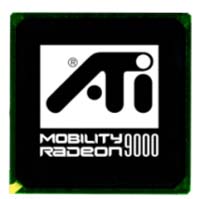ATI Mobility Radeon 9000: Raising the bar again
by Matthew Witheiler on August 29, 2002 5:00 AM EST- Posted in
- Laptops
The Chip(s)
There are actually going to be five versions of the Mobility Radeon 9000 floating around out there. All are based on the RV250 core but distinguish themselves in terms of configuration, clock speed, and memory bus width.
In order to minimize the requirements for the Mobility Radeon 9000, ATI decided to create a memory on chip solution, producing one of the three different packaging variations of the chip. The memory on chip solution implemented by ATI is essentially the same as the memory on chip method that was introduced with the GeForce4 Go chips with their Mobile AGP Package (MAP) design.
Finding space and making traces for external video memory is not an easy task in the cramped confides of a notebook. Previously, video processor manufacturers dealt with these problems by including on die memory. This served to lessen the headaches encountered when dealing with external memory solutions but introduced new problems into the actual chip production.
Due to size constraints there is only a limited amount of video memory that can be integrated onto a chip's die. Even a fairly small amount of integrated memory creates a large die that results in higher chip prices and higher failure rates. It is for this reason that mobile graphics chips with on die memory are typically only used in specific mobile systems where space is at the largest premium and fast 3D performance is not necessary (as the chips are usually limited to, at most, 16MB of on die memory).
The solution to this problem that both ATI and NVIDIA have come to was only made possible recently with the release of BGA memory. Thanks to BGA memory's small package size, on chip memory solutions have become not only possible but fairly easy to create. The process involves mounting the GPU and the BGA memory on the same substrate, with the GPU core going on the bottom and the memory going on the top.

The memory on chip Mobility Radeon 9000.
The Mobility Radeon 9000 comes in two on chip memory configurations. The first is the high-end 64MB solution that includes 64MB of memory connected to the GPU via a 128-bit DDR memory bus. This chip is called the Mobility Radeon 9000 S64. The second is a lower-end solution that includes 32MB of on chip memory but only has a 64-bit DDR memory bus. This variation is called the Mobility Radeon 9000 E32. Like any video chip that includes a 64-bit DDR memory bus, we can except performance of the 32MB on chip Mobility Radeon 9000 to be a good amount lower than the 64MB on chip version. The naming convention denotes the memory bus width (S for 128-bit, E for 64-bit) followed by the video memory size (64 for 64MB, 32 for 32MB).
The memory on chip Mobility Radeon 9000 will likely find its way into thin and light notebooks. Next year ATI predicts that we will see a Mobility Radeon 9000 S64 running in a thin and light notebook with a Banias processor under the hood. If this proves to be the case, mobile gaming will enter a place it has never been before: in the thin and light segment.
With ATI's announcement that memory on chip Mobility Radeon 9000's will be shipping in notebooks next week, the company seems to be the first to actually be shipping an integrated memory video product for the mobile market. This is because NVIDIA's MAP chips have yet to find their way into shipping notebooks as far as we can tell.
The Mobility Radeon 9000 also comes in a discrete chip package like the ones found on desktop video cards. This chip has the same features as the Mobility Radeon 9000 with on chip memory and is available with both a 128-bit and a 64-bit DDR memory bus. The discrete Mobility Radeon 9000 will likely find its way into high-end, high weight desktop replacement notebooks where the space savings offered by the on chip memory does not make up for the higher price.

The discrete Mobility Radeon 9000.










0 Comments
View All Comments